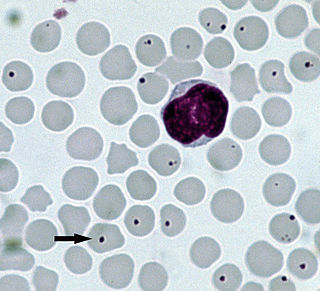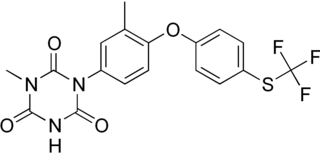
Q fever or query fever is a disease caused by infection with Coxiella burnetii, a bacterium that affects humans and other animals. This organism is uncommon, but may be found in cattle, sheep, goats, and other domestic mammals, including cats and dogs. The infection results from inhalation of a spore-like small-cell variant, and from contact with the milk, urine, feces, vaginal mucus, or semen of infected animals. Rarely, the disease is tick-borne. The incubation period can range from 9 to 40 days. Humans are vulnerable to Q fever, and infection can result from even a few organisms. The bacterium is an obligate intracellular pathogenic parasite.

Coccidia (Coccidiasina) are a subclass of microscopic, spore-forming, single-celled obligate intracellular parasites belonging to the apicomplexan class Conoidasida. As obligate intracellular parasites, they must live and reproduce within an animal cell. Coccidian parasites infect the intestinal tracts of animals, and are the largest group of apicomplexan protozoa.

Haemonchus contortus, also known as the barber's pole worm, is a very common parasite and one of the most pathogenic nematodes of ruminants. Adult worms attach to abomasal mucosa and feed on the blood. This parasite is responsible for anemia, oedema, and death of infected sheep and goats, mainly during summer in warm, humid climates.
Coccidiosis is a parasitic disease of the intestinal tract of animals caused by coccidian protozoa. The disease spreads from one animal to another by contact with infected feces or ingestion of infected tissue. Diarrhea, which may become bloody in severe cases, is the primary symptom. Most animals infected with coccidia are asymptomatic, but young or immunocompromised animals may suffer severe symptoms and death.

Eimeria tenella is a species of Eimeria that causes hemorrhagic cecal coccidiosis in young poultry. It is found worldwide.

Eimeria is a genus of apicomplexan parasites that includes various species capable of causing the disease coccidiosis in animals such as cattle, poultry and smaller ruminants including sheep and goats. Eimeria species are considered to be monoxenous because the life cycle is completed within a single host, and stenoxenous because they tend to be host specific, although a number of exceptions have been identified. Species of this genus infect a wide variety of hosts. Thirty-one species are known to occur in bats (Chiroptera), two in turtles, and 130 named species infect fish. Two species infect seals. Five species infect llamas and alpacas: E. alpacae, E. ivitaensis, E. lamae, E. macusaniensis, and E. punonensis. A number of species infect rodents, including E. couesii, E. kinsellai, E. palustris, E. ojastii and E. oryzomysi. Others infect poultry, rabbits and cattle. For full species list, see below.

Sarcocystis is a genus of protozoan parasites, with many species infecting mammals, reptiles and birds. Its name is dervived from Greek sarx = flesh and kystis = bladder.

Anaplasmosis is a tick-borne disease affecting ruminants, dogs, and horses, and is caused by Anaplasma bacteria. Anaplasmosis is an infectious but not contagious disease. Anaplasmosis can be transmitted through mechanical and biological vector processes. Anaplasmosis can also be referred to as "yellow bag" or "yellow fever" because the infected animal can develop a jaundiced look. Other signs of infection include weight loss, diarrhea, paleness of the skin, aggressive behavior, and high fever.
Mycoplasma ovipneumoniae is a species of Mycoplasma bacteria that most commonly inhabits and affects ovine animals, first described in 1972. M. ovipneumoniae contributes to harmful pneumonia in sheep and goats. The duration and severity of M. ovipneumoniae varies from region to region.
Muelleries capillaris, also known as the hair or goat lungworm, is one of the most economically important nematodes of small ruminants. Although normally non-pathogenic in sheep, the parasite causes a disease condition called muelleriosis in goats. Sheep and goats commonly become infected after accidentally ingesting M. capillaris infected snails or slugs, and the parasite produces eggs in the lungs of its host, causing life-threatening bronchopneumonia in serious cases.

Protozoan infections are parasitic diseases caused by organisms formerly classified in the kingdom Protozoa. These organisms are now classified in the supergroups Excavata, Amoebozoa, Harosa, and Archaeplastida. They are usually contracted by either an insect vector or by contact with an infected substance or surface.

Diclazuril is a coccidiostat.

Toltrazuril is an antiparasitic medication used primarily to treat coccidiosis in animals. Coccidiosis is a parasitic disease caused by coccidia, which are microscopic, spore-forming, single-celled obligate intracellular parasites belonging to the apicomplexan class Conoidasida.

Pediococcus acidilactici is a species of Gram-positive cocci that is often found in pairs or tetrads. P. acidilactici is a homofermentative bacterium that can grow in a wide range of pH, temperature, and osmotic pressure, therefore being able to colonize the digestive tract. It has emerged as a potential probiotic that has shown promising results in animal and human experiments. However, some of the results are limited. They are commonly found in fermented vegetables, fermented dairy products, and meat.

Oxfendazole is a broad spectrum benzimidazole anthelmintic. Its main use is for protecting livestock against roundworm, strongyles and pinworms. Oxfendazole is the sulfoxide metabolite of fenbendazole.

Cystoisospora is a genus of parasitic alveolates belonging to the phylum Apicomplexa.
Paramphistomum cervi, the type species of Paramphistomum, is a parasitic flat worm belonging to the class Trematoda. It is a tiny fluke mostly parasitising livestock ruminants, as well as some wild mammals. Uniquely, unlike most parasites, the adult worms are relatively harmless, but it is the developing juveniles that cause serious disease called paramphistomiasis, especially in cattle and sheep. Its symptoms include profuse diarrhoea, anaemia, lethargy, and often result in death if untreated.
Eimeria zuernii is a species of the parasite Eimeria that causes diarrheic disease known as eimeriosis in cattle, and mainly affects younger animals. The disease is also commonly referred to as coccidiosis. The parasite can be found in cattle around the globe.
Eimeria bovis is a parasite belonging to the genus Eimeria and is found globally. The pathogen can cause a diarrheic disease in cattle referred to as either eimeriosis or coccidiosis. The infection predominantly cause disease in younger animals.
Eimeria falciformis is an obligate intracellular parasite that primarily infects the mouse species Mus musculus. As part of the Apicomplexa phylum, it has a complex life cycle within its host, causing tissue necrosis and inflammation, particularly in the cecum. This leads to coccidiosis, a disease characterized by symptoms like diarrhoea and weight loss. E. falciformis is one of over 1,700 species in the Eimeria genus, which infects the intestinal epithelial cells of various animals, including poultry and livestock.












